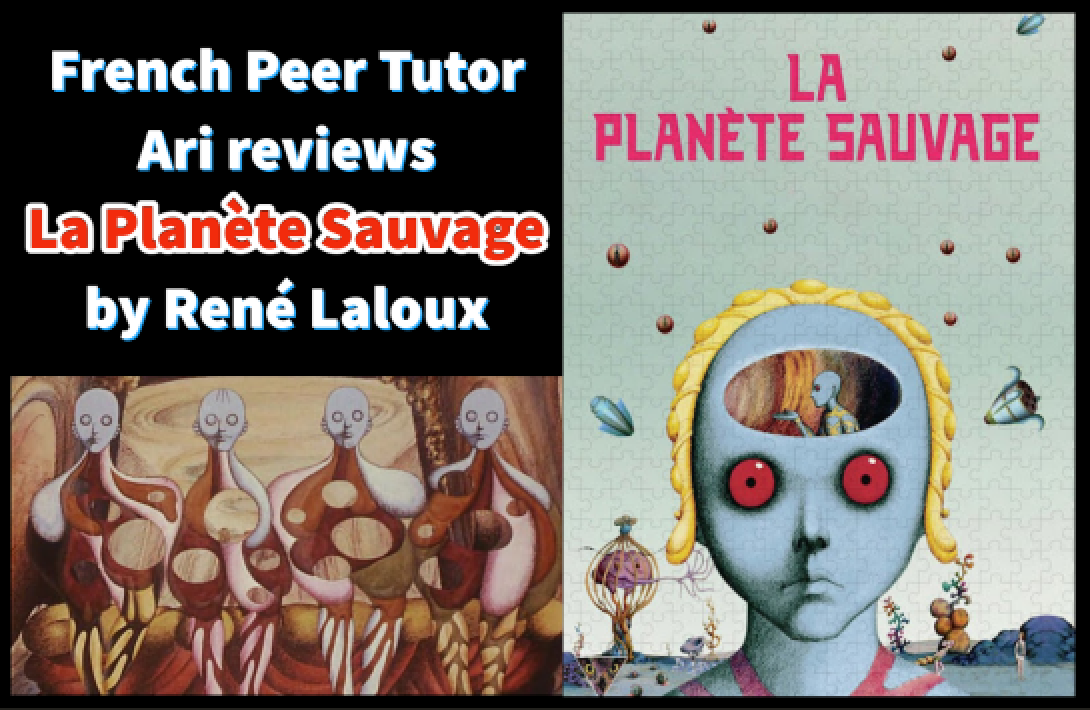4.8.2022: Ari reviews the French film La Planète Sauvage (Fantastic Planet)
Ari reviews La Planète Sauvage by René Laloux

La Planéte Sauvage or Fantastic Planet in English, by René Laloux is a surreal animation created in 1973, based on the novel Oms en série by Stefan Wul. We start off this film with a mother, clutching onto her child as she runs through a strange and winding forest. Her expression is that of fear and desperation and as she’s running up a hill, a large blue hand emerges from the sky. The disembodied hand proceeds to shove the woman down the hill. Stumbling to get up and run up the hill again, the hand once more flicks her down the hill. It’s toying with her, similar to how a child picks at worms or ants. After a while of torment, one of the hands picks up the woman and drops her to the ground, proving lethal. This scene is our introduction to the ‘Oms,” a play on the French word “Homme,” meaning “man.” The Oms live on a planet ruled by giant blue humanoid beings, called “Draags.” It is revealed that the chaotic hands emerging from the sky were, in fact, children whose cruelty had now left a young Om baby, without a mother.
This opening scene establishes perfectly the relationship between Oms and Draags. In the movie, the Oms are little more than a pest to the Draags, existing as wild animals in the wastelands of the planet, or best case scenario, serving as pets to the Draags. The film deals with heavy subjects such as human identity, intolerance, enslavement, and genocide. The story follows the now orphaned baby Om, who was rescued by another young Draag after witnessing her classmates thoughtlessly kill the mother Om. The baby Om, now named Terr, grows an attachment to his new owner, Tiwa, who lets Terr use an almost magical headset to educate himself on the Planet Ygam and the Draag species. With the headset, Terr learns how to understand Draag writing and language. Using his newfound knowledge, Terr escapes with the headset to educate other Om’s, in order to end his specie’s suffering under tyrannical Draag rule.
The Draags serve as a direct parallel to human behavior. In a strange way, the draags mimic humans’ treatment towards animals, and even other humans. The Draags constantly classify the Oms as insects, underestimating their intelligence and “de-Omming” the surrounding areas of their town every so often. In the opening scene, we witness young Draags nonchalantly massacring an Om and when she dies, they are not saddened by the death of another being but they are upset that their “toy” can no longer entertain them. We witness intense scenes of the “De-omming”, lending major credence to the themes of genocide in the film, as the Draags carelessly wipe out entire colonies of Oms like a termite infestation. This serves as a hypocrisy: humans replicate the same behavior everyday and when the roles are reversed, we find ourselves sympathizing with the “pests.”
The paper cutout animation utilizes still illustrations and moves them frame by frame under a camera. This animation style reminds me of shows like South Park or Monty Python. This allows the movie to have abrupt and sudden movements, giving it an otherworldly effect on the story. The meditation scene is the most disturbing scene to me, for good reason. The Draag’s participated in meditation rituals in order to communicate with each other and travel through space and time. Essentially, meditation scenes depict the Draags metamorphizing and “melting” into each other.
Overall, the animation perfectly compliments the storyline and vibe of the film, without distracting from the theme of the story.
The soundtrack is also insanely beautiful and is worth a listen by itself. Composed by Alain Goraguer, the soundtrack includes wah-wah guitar strumming and synthesizer noises that create a very futuristic style perfectly fitting for such a bizarrely beautiful movie. This film’s album is notorious in the hip-hop industry and has been sampled by many artists, like Mac Miller, MF Doom, Madlib, Flying lotus, Denzel Curry, and many more. Both the music and the art style combined elevate the film to a completely different level and left a lasting impression on pop-culture.
Overall, I thoroughly enjoyed this film and will be recommending it to my peers. Though I would not recommend this film for young children, since it deals with such severe themes and heavy nudity, I would say it is an important film to watch and dissect. Children will not be able to fully understand the film since most of its messaging has to be interpreted through dialogue and previous knowledge of sci-fi horror and human behaviors. Additionally, although the art style is captivating, it uses duller colors and is oftentimes scary for people of all age groups. You can stream the film for free with English subtitles through Kanopy with UIC university logins or you can also stream it through Youtube for free. Young adults would be the target audience as it allows them to view a different perspective of human behavior and gain a more empathetic mentality. I know personally, I will never view a bottle of Raid the same again.